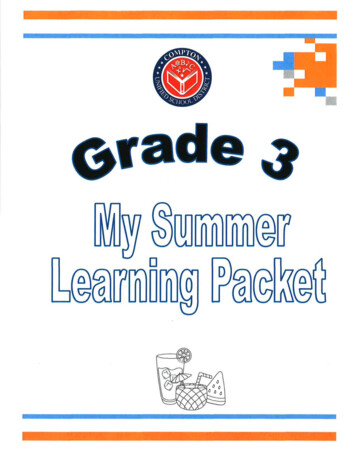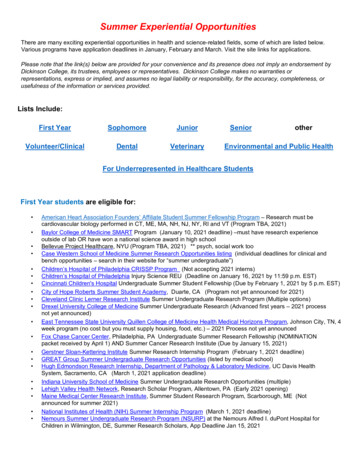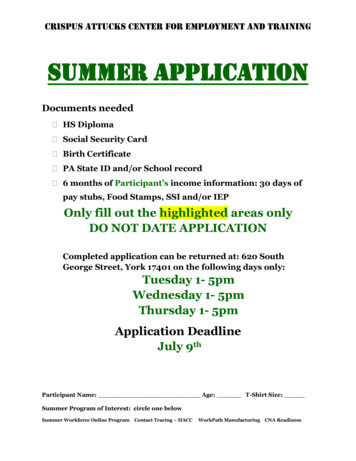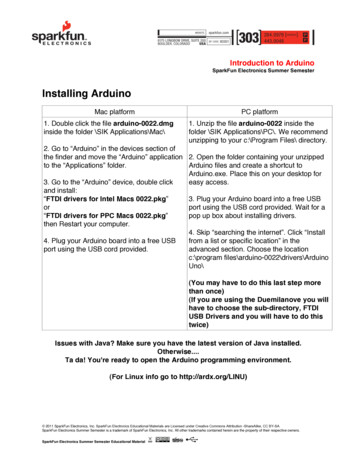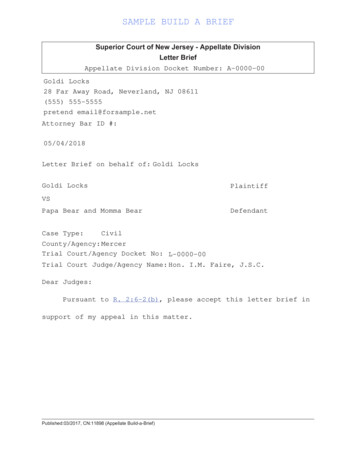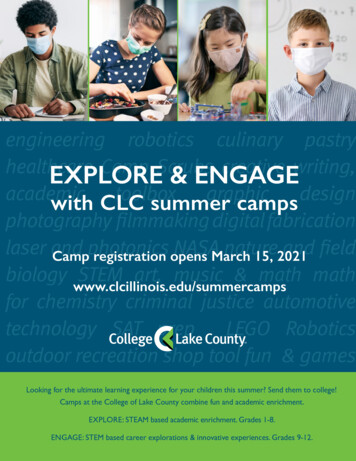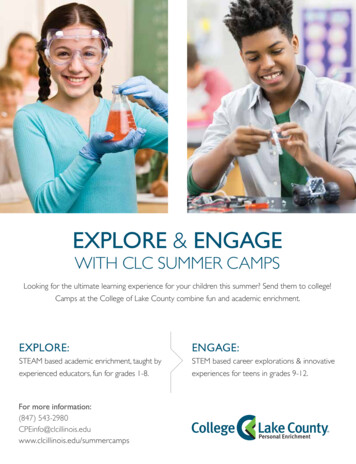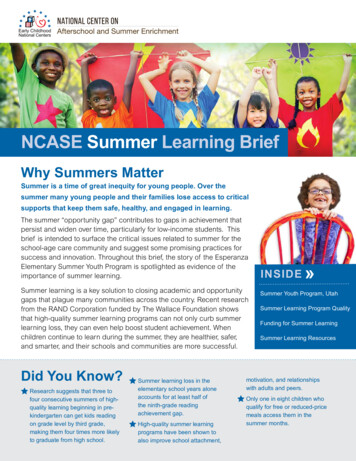
Transcription
NCASE Summer Learning BriefWhy Summers MatterSummer is a time of great inequity for young people. Over thesummer many young people and their families lose access to criticalsupports that keep them safe, healthy, and engaged in learning.The summer “opportunity gap” contributes to gaps in achievement thatpersist and widen over time, particularly for low-income students. Thisbrief is intended to surface the critical issues related to summer for theschool-age care community and suggest some promising practices forsuccess and innovation. Throughout this brief, the story of the EsperanzaElementary Summer Youth Program is spotlighted as evidence of theimportance of summer learning.Summer learning is a key solution to closing academic and opportunitygaps that plague many communities across the country. Recent researchfrom the RAND Corporation funded by The Wallace Foundation showsthat high-quality summer learning programs can not only curb summerlearning loss, they can even help boost student achievement. Whenchildren continue to learn during the summer, they are healthier, safer,and smarter, and their schools and communities are more successful.Did You Know?R esearch suggests that three tofour consecutive summers of highquality learning beginning in prekindergarten can get kids readingon grade level by third grade,making them four times more likelyto graduate from high school.S ummer learning loss in theelementary school years aloneaccounts for at least half ofthe ninth-grade readingachievement gap.H igh-quality summer learningprograms have been shown toalso improve school attachment,INSIDE«Summer Youth Program, UtahSummer Learning Program QualityFunding for Summer LearningSummer Learning Resourcesmotivation, and relationshipswith adults and peers.O nly one in eight children whoqualify for free or reduced-pricemeals access them in thesummer months.
EsperanzaElementarySummer YouthProgram, UtahEsperanza Elementary School,supported by a grant fromthe Department of WorkforceServices Office of Child Care,provided Summer YouthProgram services 4.5 hoursa day, five days per week,for six weeks to preventsummer learning loss amongEsperanza Elementarystudents. Through continuedfunding, Esperanza will continueto provide the same program inthe summer of 2016 and 2017.The program providedreading intervention using theReading A–Z curriculum, mathinstruction using the Bridgesin Mathematics curriculum,hands-on science exploration,and recreation and enrichmentactivities. Students wereQuality Counts!Summer Learning ProgramQuality and ImprovementRegular attendance in highquality summer programs isassociated with a range ofpositive academic and socialdevelopment outcomes,including improved skills inliteracy,2 improved self-esteemand leadership skills.3While summer learningprograms have the potentialto help close the achievementgap and provide valuableopportunities for children, not allsummer programs are createdequal. Research in afterschoolhas shown that programattendance alone is notsufficient to make a differencefor young people and thatas many as half of existingprograms show no positiveyouth outcomes.4 It takes highquality programming to make alasting impact on children andyouth.It takes high-qualityprogramming to makea lasting impact onchildren and youth.Among the defining characteristicsof high-quality summer learningprograms that RAND identifies are:H ighly-qualified and speciallytrained staff, along with earlyplanning that engages partnerswith clearly delineated rolesS maller class sizes,individualized instruction, andsufficient time on task (operatingthe program for at least fiveweeks, with three to four hoursof academics per day)I nvolving families andmaximizing student attendancewith firm enrollment deadlines,Read more about high-quality summer learning programsat work at summerlearning.org/summerexcellence.
30 minutes per day in scienceactivities; and 45 minutes perday in enrichment activities.Enrichment activities includedrecreation and physical activity,cultural activities in music andMariachi, and the opportunity tolearn and master playing chess.actively engaged 90 minutesper day in readingand writingactivities; 45minutes perday in mathactivities;Especially for EnglishLanguage Learners (ELLs),who make up 59 percent ofEsperanza’s student body,participation in afterschool andsummer learning designedspecifically with their needsSpotlighton Qualityclear attendance policies,and electronic studentrecordsS trategic use ofpartnershipsU sing evidence-based,commercially availablecurricula, and standardizingits use across sitesP roviding carefully planned,engaging enrichmentactivities2. Chaplin, D., & Capizzano, J. (2006). Impacts ofa summer learning program: A random assignmentstudy of Building Educated Leaders for Life (BELL).Washington, DC: The Urban Institute/MathematicaPolicy Research.3. Bialeschki, M.D., Henderson, K.A., & James,P.A. (2007). Camp experiences and developmentaloutcomes for youth. Child and Adolescent PsychiatricClinics of North America, 16, 769–788.4 Granger, R., Durlak, J. A., Yohalem, N., & Reisner,E. (April, 2007). Improving after-school programquality. New York, NY: William T. Grant Foundation.99%maintained orincreased readingproficiency levels82%of studentsmaintained orincreased mathproficiency levels81%maintainedor increasedknowledge ofphysical activityand nutritionin mind has been associatedwith improvements inacademic performance andimproved social and linguisticdevelopment.11. Hirsch, B. J. (2011). Learning and developmentin after-school programs. Phi Delta Kappan, 92(5),66–69.Garcia, E. E., & F Téllez, K., & Waxman, H. C.(2010). A review of research on effective communityprograms for English language learners. The SchoolCommunity Journal, 20(1), 103–119.Pray, L. (2012). Supporting English languagelearners in school and in afterschool andsummer programs. In T. K. Peterson(Ed.), Successes and Potential of 21st CenturyCommunity Learning Centers: ExpandedLearning Opportunities, Partnerships, Afterschooland Summers Across America. Flint, MI: MottFoundation.In Esperanza Elementary’sSummer Youth Program, 99percent maintained or increasedreading proficiency levels.Students’ abilities in mathematicswere also maintained andimproved, as 82 percent ofstudents maintained or increasedmath proficiency levels.Students demonstrated increasedawareness of the importance ofphysical activity and nutritionas 81 percent of studentsmaintained or increasedknowledge of physical activityand nutrition according topre- and post-tests.The program also enjoyedexcellent parent engagementoutcomes with a higher thananticipated rate of parentparticipation in Summer YouthProgram family activities,including National SummerLearning Day, ongoing parentvolunteer opportunities, and theend-of-summer family celebration.NCASE SUMMER LEARNING BRIEF 2016
Funding forSummer Learningand School-Age CareGiven the demonstrated need for high-quality summer learning experiences and the impactsuch programs can have on promoting outcomes for children and youth, it is critical thatpublic and private organizations understand available funding sources to provide greateraccess to quality programs.A major source of publicfunding for summer learningprograms comes from theFederal Child Care andDevelopment Block Grant(CCDBG), which providesChild Care and DevelopmentFund (CCDF) support to states,territories, and Tribes acrossthe U.S. to help offset the costof child care for children infamilies of low income. TheseCCDF funds offer criticalsupport to working families toprovide access to high-qualitychild care year-round, includingduring the summer.In 2014, Congress reauthorizedthe CCDBG Act for the firsttime since 1996, ushering insweeping new changes tohealth and safety, licensing,monitoring of license-exemptprograms, consumer education,and other changes designedto increase safety and improvequality of child care programs,including summer learningprograms. In addition to theprovisions included within theCCDBG Act, the December2015 passage of the EveryStudent Succeeds Act (whichreauthorized the Elementaryand Secondary EducationAct through 2020) ensuressignificant investments insummer learning. This newbill maintains many importantprotections for low-incomestudents, while giving statesand districts greater flexibilityto choose the educationstrategies that fit their needs.It has changed the fundinglandscape for out-of-schooltime and community-basedprograms. As a result, agrowing number of states haveprioritized summer learning,which has led to increasedsupport at the community level.Learn more about summer learning funding atsummerlearning.org/summer-opportunity-project.
Summer LearningResourcesProgram Quality and Improvement ResourcesMaking Summer Count: How Programs Can BoostChildren’s LearningSummer Starts in September Planning TimelineSummer Learning Program Quality InterventionTip Sheets for ParentsPolicy and Funding ResourcesRecommendation for Policymakersand Funders2016 Funding Resource GuideSummer Learning Research-in-Brief SeriesSummer LearningFunding at WorkEsperanza Elementary’sSummer Youth Programis currently operating withDepartment of WorkforceServices Office of Child Caregrant funds and supplementalincome generated by theschool funding formula from theUtah State Office of Education,which cover facilities costsand a portion of the cost ofprogram management andadministration.Esperanza Elementaryis actively seeking otherfunding sources to expandservices and provide longterm sustainable revenue forthe Summer Youth Programthrough a variety of fundingstreams. This will ideally bea combination of low-costsliding scale fees; corporate,public, and private foundationfunds; and government formulafunding and grants.NCASE SUMMER LEARNING BRIEF 2016
How to Create a SuccessfulStrategy for Accessing FederalFunds for Summer LearningSeveral key strategies can help summer learning providersimprove their chances of effectively accessing federal funding:Understand the landscapefor federal programs,including how and when thegrants are funded, who iseligible to receive the funds,and the purpose or goals forthe funding.Partner with Child Care andDevelopment Fund leadagencies to support summerlearning programs.Plan early to bestsynchronize timing for grantawards, school districtbudget cycles, and highquality summer learning.Ongoing research fromthe RAND Corporation hasfound that program leaderswho began planning inJanuary were able to runprograms more smoothly,with less disruption toacademic instruction.Partnerships at WorkEsperanza Elementarydeveloped several keypartnerships that providedvolunteer and in-kind donationsover the summer. Thesepartnerships were cultivatedthrough cooperation betweenschool administration and theSummer Youth Program staff:Utah State University providedvaluable in-kind resourcesin personnel, materials, andcurriculum for their SummerFinance Camp and SummerService Learning: Sharing IsCaring. The University’s Department of Art and Art History alsoprovided volunteer art teachingC ontinually work to buildpartnerships so that summerlearning programs canaccess funding even if theydo not directly receive fundsthrough formulas, or cannotapply directly for competitivegrant funds.C ollect, analyze, and sharestrong outcome data toprove that summer learningprograms are successful.M ake communities, schools,and parents aware ofsummer programs and theirbenefits in order to buildsupport and advocacy.students, as well as curriculumand guidance in implementing4-H curriculum in health,nutrition, and physical fitness.A partnership with the locallibrary made it possible forsummer program students tolearn about the many libraryresources available to themand to participate insummer library programs.This document was developed with funds from Grant #90TA00001-01 for the U.S. Department of Health and Human Services, Administrationfor Children and Families, Office of Child Care, by the National Center on Afterschool and Summer Enrichment. This resource may beduplicated for noncommercial uses without permission.
NCASE Summer Learning Brief Why Summers Matter Summer is a time of great inequity for young people. Over the . math instruction using the Bridges in Mathematics curriculum, hands-on science exploration, and recreation and enrichment . for Children and Families, Office of Child Care, by the National Center on Afterschool and Summer .
